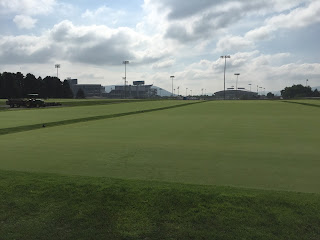We all know how important university research is to the vitality and future success of our industry. This post will serve as the first feature of a blog mini-series highlighting the research being conducted around the Mid-Atlantic region. Next time, I will take you inside the research programs at the University of Maryland and Virginia Tech. To get us started, here is a little bit of what's going on in Happy Valley.
Dr. Max Schlossberg's research trials on Kentucky bluegrass are evaluating efficiency and recovery of controlled-release granular nitrogen fertilizers. These studies involve weekly measures of canopy color/density, growth, and fertilizer-N recovery. Field trials investigating organic N fertilizers and liming agents are also underway. Lastly, the Turfgrass Nutrition team is repeating several flux-chamber studies measuring ammonia volatilization (loss) following foliar and granular applications of urea and stabilized-urea fertilizers. The outcomes of this N-fertilizer research include guidance on fertilizer selection, rate(s), and cultural practice that support resilient golf course roughs, sports fields, and lawns; while limiting non-point N loading of water resources.
Dr. Ben McGraw and his team are working on interesting research involving turfgrass ants. Some believe that turfgrass ants are major predators of Annual Bluegrass Weevil (ABW) eggs, and Dr. McGraw wants to learn more. By monitoring these ant colonies using pit-fall traps and ABW egg stations, the entomology team hopes to gain insight into the impact that ants have on ABW populations. In answering this question, Dr. McGraw would gain insight on whether conserving these ants on fairways may actually help reduce ABW populations in the future.
Dr. Max Schlossberg's research trials on Kentucky bluegrass are evaluating efficiency and recovery of controlled-release granular nitrogen fertilizers. These studies involve weekly measures of canopy color/density, growth, and fertilizer-N recovery. Field trials investigating organic N fertilizers and liming agents are also underway. Lastly, the Turfgrass Nutrition team is repeating several flux-chamber studies measuring ammonia volatilization (loss) following foliar and granular applications of urea and stabilized-urea fertilizers. The outcomes of this N-fertilizer research include guidance on fertilizer selection, rate(s), and cultural practice that support resilient golf course roughs, sports fields, and lawns; while limiting non-point N loading of water resources.
Dr. Ben McGraw and his team are working on interesting research involving turfgrass ants. Some believe that turfgrass ants are major predators of Annual Bluegrass Weevil (ABW) eggs, and Dr. McGraw wants to learn more. By monitoring these ant colonies using pit-fall traps and ABW egg stations, the entomology team hopes to gain insight into the impact that ants have on ABW populations. In answering this question, Dr. McGraw would gain insight on whether conserving these ants on fairways may actually help reduce ABW populations in the future.
Speaking of ABW, Dr. McGraw’s graduate student, Ben Czyzewski, is researching how different greens cultural practices (mowing height and N fertility) affect ABW survival rates, egg laying, and larval development. Since ABW damage is rarely reported on greens, this research helps gain insight into whether or not ABW can lay eggs on greens-height grass. Furthermore, Ben is learning more about ABW foraging activities using a time lapse camera – pretty cool. He actually marks the adult ABWs with a UV pen, and then can easily pick up their activity on the camera.
Dr. Kaminski and his research technician, Tim Lulis, are embarking on a long-term study looking at how to maximize playability without compromising plant health. In short, what is the point of diminishing returns when it comes to high intensity management and the expected gains? The idea is to come up with a sort of mathematical equation that can be used to attain maximum playability with the fewest necessary inputs. Think: Is that extra roll or cut necessary to attain speeds of “X”? Or, given “X” weather conditions, your greens can only attain “Y” speeds, with “Z” inputs. Complex, yes. But they hope this information is useful for tournament preparation in the future.
Some of the influencing factors include mowing frequencies, mowing heights, etc. As far as data collection, there is a ton, including thermal photography, ball roll, and plant color and quality. They are currently working on a bentgrass green, with plans to replicate the study on a fine fescue green as well. Pretty interesting.
Dr. Landschoot is working on some research that aims to control poa annua within a Kentucky bluegrass stand. While controlling poa is hard enough, controlling poa in a stand of Kentucky bluegrass is even harder, since both grasses are in the same genus. His research is showing a positive response to an Exonerate and Tenacity mixture. In this case, the exonerate kills the poa, and the Tenacity serves as a pre-emergent. While there is some phytotoxicity associated with this treatment, the results are pretty promising.
Lastly, Dr. Andy McNitt and Tom Serensits, manager of Sports Turf Research, are working on a project looking at the playability of warm season grasses on athletic fields in northern climates. The trial is evaluating three bermudagrasses up against new Kentucky bluegrasses. Some of the evaluation parameters include traction and divot resistance. In other work, the McNitt group is experimenting with fraze mowing and various sodding techniques for NFL fields.
In closing, I'd like to thank all of the Penn State Turfgrass Faculty and Staff for presenting their research, and the hard work they continue to put forth to serve our industry.
 |
| A view of Valentine Turfgrass Research Center |
 |
| Dr. McGraw's pitfall traps placed around a turfgrass ant colony |
 |
| A look at Dr. Landschoot's poa control study |